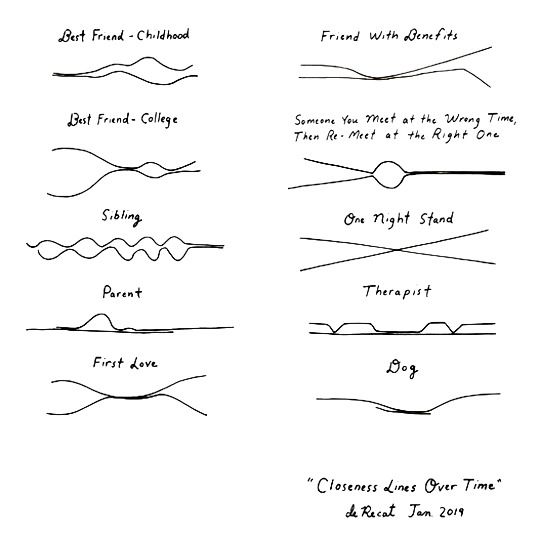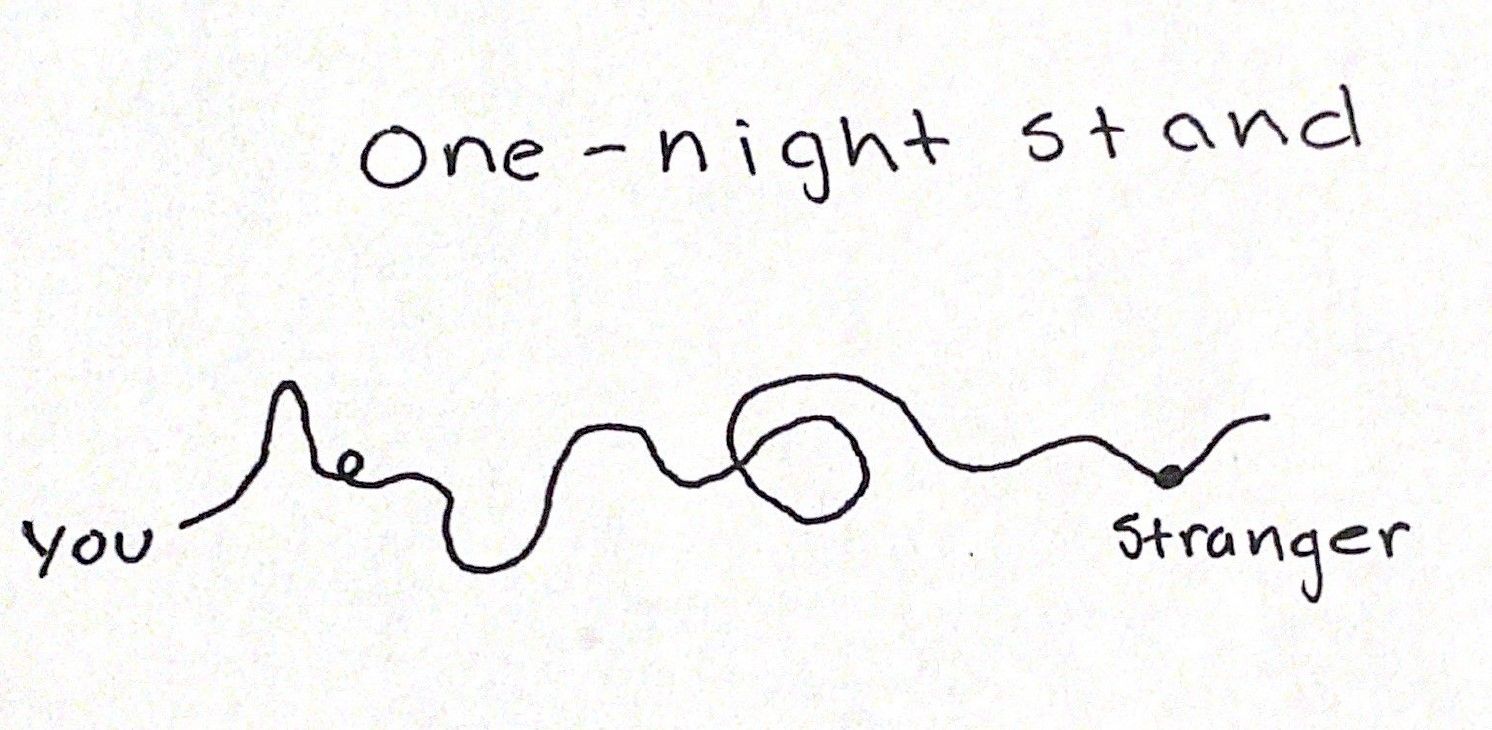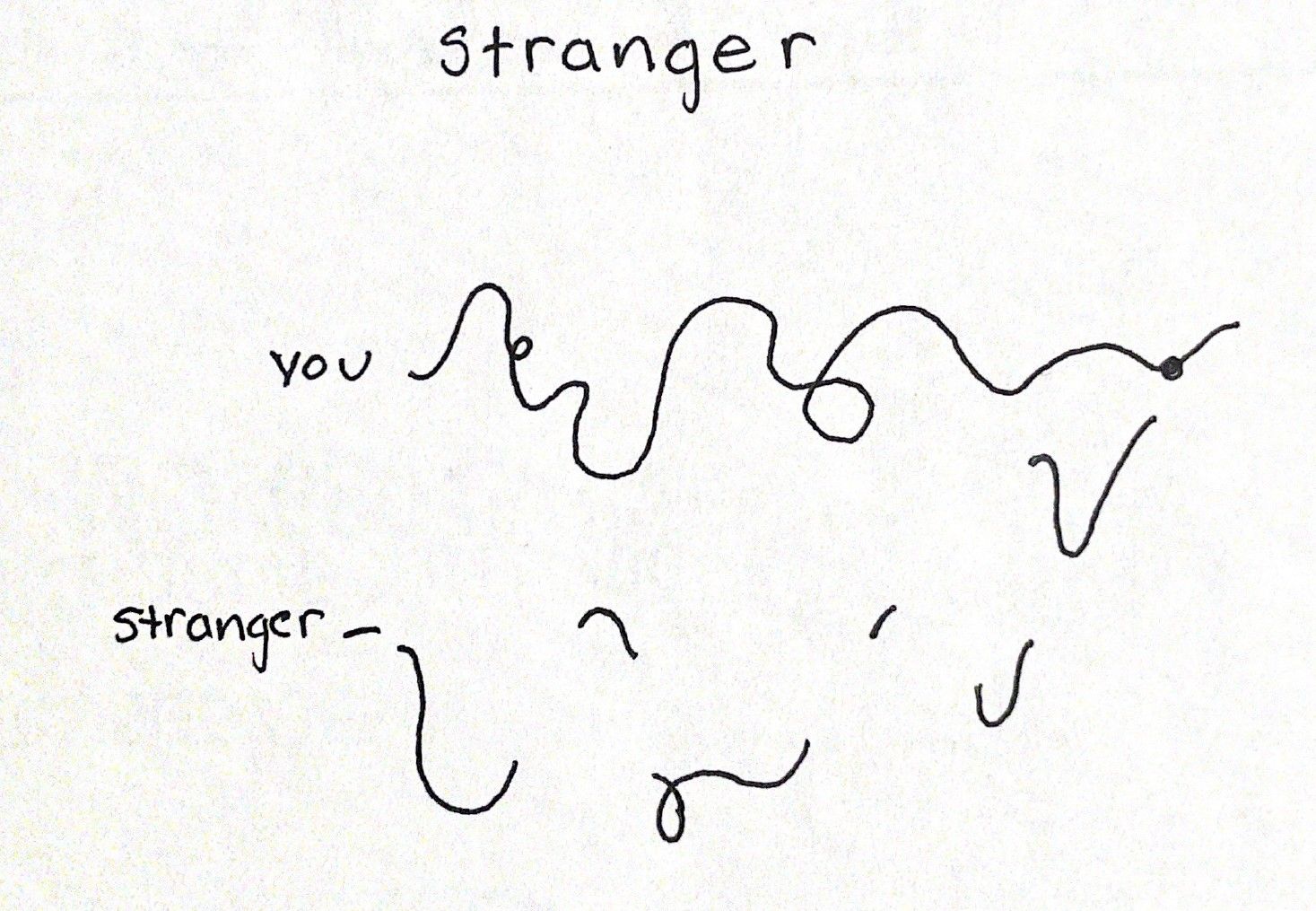The Hairdresser's Line

There's this diagram of the different type human of relationships that occasionally pops up on social media. Using lines to represent lives, the diagram depicts the variability of closeness within common relationships over time.

For the parent and child relationship, the two lines are packed closely at the start of the child's timeline, representing the closeness and mutual fervor of infancy and early childhood. Because of a bump in the child's line, the two lines diverge for some length as the child matures and becomes independent. Eventually, the lines come together once again, extending closely in parallel just prior to the end of the parent's line.
Disregarding scale, the Closeness Lines Over Time diagram is a decent representation of the relationships we develop and a poignant reminder to cherish the people we have in our lives.
However, the line diagram assumes a general and naïve perspective of each life by drawing arbitrarily winding lines to represent lives. Of course I can’t nitpick a social media post, but by design, the lines only represent the relative closeness to each individual drawn. Close lines represents an inseparable bond and while diverging ones reflects a distant bond. The lines don’t represent the nuanced trajectory of anyone’s life. It speaks little of specific events in people’s life, let alone the true winding nature of our lines.
For example, the sibling lines are wave-like threads that undulate in and out of touch but speak little about either sibling's actual life. What does each peak represent? A geographical separation or an argument? And what about the troughs?
I’m reminded of this relationship diagram because of a conversation with a hairdresser.
___
I got a haircut last week in a quaint, modest hair salon 20 minutes from my apartment. The salon is sandwiched in a complex at the mouth of a four-way intersection between a smoke shop and some fenced-off property. The salon is built several feet below the intersection so cars trudge in and out of the complex, maneuvering potholes along the ramped asphalt.
The interior of the salon fairs a bit better -It’s comfortingly normal. As expected, in the waiting area, there’s a row of fabric backed seats piled with a few dated fashion and sports catalogs. The walls are decorated with posters of models with luscious hair gazing at onlookers with intense smolders. The posters mostly inhabit the back wall closest to the four salon stations. Each station is accompanied by a black modern salon chair, a counter scattered with assorted hair products, clippers and scissors, and a square framed mirror.
As I make my observations the hairdresser asks me if I have an appointment, to which I reply, no. She then asks me how I would like my hair cut, and after my reply, appearing satisfied, nods and instructs me to take a seat in a salon chair.
It is in this chair where the relationship line diagram falters.
___
The closest representation of strangers in the relationship line diagram is the “One night stand”, in which two lines intersect once and diverge the remaining length.

Now, let’s imagine a new line diagram where every bump, turn and redirection holds significance. If we were to redraw the diagram from the first person perspective—OUR own perspective —only our line would be completely drawn, as we have complete awareness of the ups and downs of our lives. On the other hand, the lines of others would be sporadic dashes at most. Returning to the one night stand, the strangers “line” would merely be an intersecting point on ours. We know every point of our life of course, but only a single brief moment in the strangers.

The diagram of strangers, like hairdressers, are quite similar. We are aware every coil, slant and stretch of our lives, but only minimally aware of the strangers.
___
As the hairdresser works away we engage in casual conversation, slowly piecing together each others lines. The hairdresser is an elderly Mexican woman, and I learn, she has owned 3 hair salons and lived in San Antonio for the majority of her life. She’s welcoming, like a grandmother, so when she intertwines frequent swearing in her sentences I can’t help but smile at her true youth.
I comment on the framed artwork on her wall; a crayon cloud drawing to the right and a vase and flower still life on the left. The hairdresser tells me the still life was painted by her daughter, an intelligent and beautiful lady who studied both business and computer science.
I follow up the small talk and ask how her daughter is. It is then when she shares the chasmic dip in her line. With steady flicks of the clippers, she tells me her daughter passed away of ovarian cancer. The hairdresser gently steps back and eyes the side of my head. She chuckles solemnly and says, “I tell people ‘that bitch died on me’, because if I say it any other way I start crying. God bless her soul.”
After I offer my condolences we are both silent for a brief moment. With practiced composure, she guides my head sideways and returns to clipping. The steady buzz and flicks vibrate my skull, adding more noise to my amorphous thoughts. How do you offer your heart to a stranger, especially knowing what you can offer is very little?
As if reading my mind, she smiles and says, “but you’re too young to know about death”. And she’s right.
As we talk (I am mostly listening attentively), I piece together more points to draw a few dashed lines. On the subject of loss she eventually tells me her sister in law in Hawaii passed of diabetes after years on dialysis. In addition to her familial losses, she shares that her ex husband didn’t help pay for her daughter’s funeral. And while pointing to a photo of a young kid adjacent to the cloud drawing, I learn she’s taking care of her grandson too. For every detail of her life I listen and draw.
Towards the end of the cut I thank her for sharing her life and briefly comment on her writing a book about it. She swivels my chair and hands me a mirror to admire her work. I run my fingers through my hair and tilt my head side-to-side. I inspect my sideburns, evenly sliced mid-ear length, and tell her the cut is perfect. As she removes the cape she finally addresses my comment and unabashedly shares that she can’t read or write. Before I pay and bid her farewell, she offers another coil of her life. Growing up she was expected to “be pretty and get pregnant”.
___
As I reflected on our conversation, I struggled on what to conclude. Naturally, I thought, life is precious and fragile, and not without everyone’s share of suffering. Although true, that doesn’t capture the conversation entirely.
As we all know, it’s embarrassingly easy to live within our own lines. We constantly twist and turn, yearning for moments of serenity only to find ourselves using them to undo the knots. While I navigate my new life, I’m learning to forgive myself for the difficulties of starting anew. There is no shame in tending to your line, but it begs the question: how do you care for yourself while not losing track of lives elsewhere?
I’m compelled not only by the pieces of life the hairdresser shared, but the fact that she invited it in the first place. However, I've yet to experience a sliver of her loss, so I may empathize, but I will always fail to truly understand. I fail to understand the pain and heartache of family lost too soon and I fail to understand a life without written word. I fail to understand lives that are not my own.
In 30 minutes, she’s intersected with my line and shared the coils of her own. With each detail she shared we slowly relinquished our titles as strangers.
In the new line diagram I offer, you can only know the path of your line. The closeness of parent and child is still depicted in distance but now we acknowledge the gaps where we each individual knows little. Strangers are merely points, only bisecting our lines once and usually never again. But whether mother, stranger, friend, or significant other, the state of each line remains dynamic. Even as we grow our line, making decisions to straighten or turn we can also piece together the bumps and knots of others. We may never fully understand another's life, after all, it's not our own, but I think we should expect ourselves to try. All we have to do is listen and draw.

Thanks for reading! If you liked it, please share it with a friend! If you didn't, I'm sorry. :(
Email me (openthoughtblog@gmail.com) and let me know how I did or if you have any critiques, comments or recommendations. If you liked this or any other post, please consider subscribing. :)
Member discussion